wheel FORD SIERRA 1985 1.G Bodywork And Fittings Workshop Manual
[x] Cancel search | Manufacturer: FORD, Model Year: 1985, Model line: SIERRA, Model: FORD SIERRA 1985 1.GPages: 22, PDF Size: 1.2 MB
Page 1 of 22
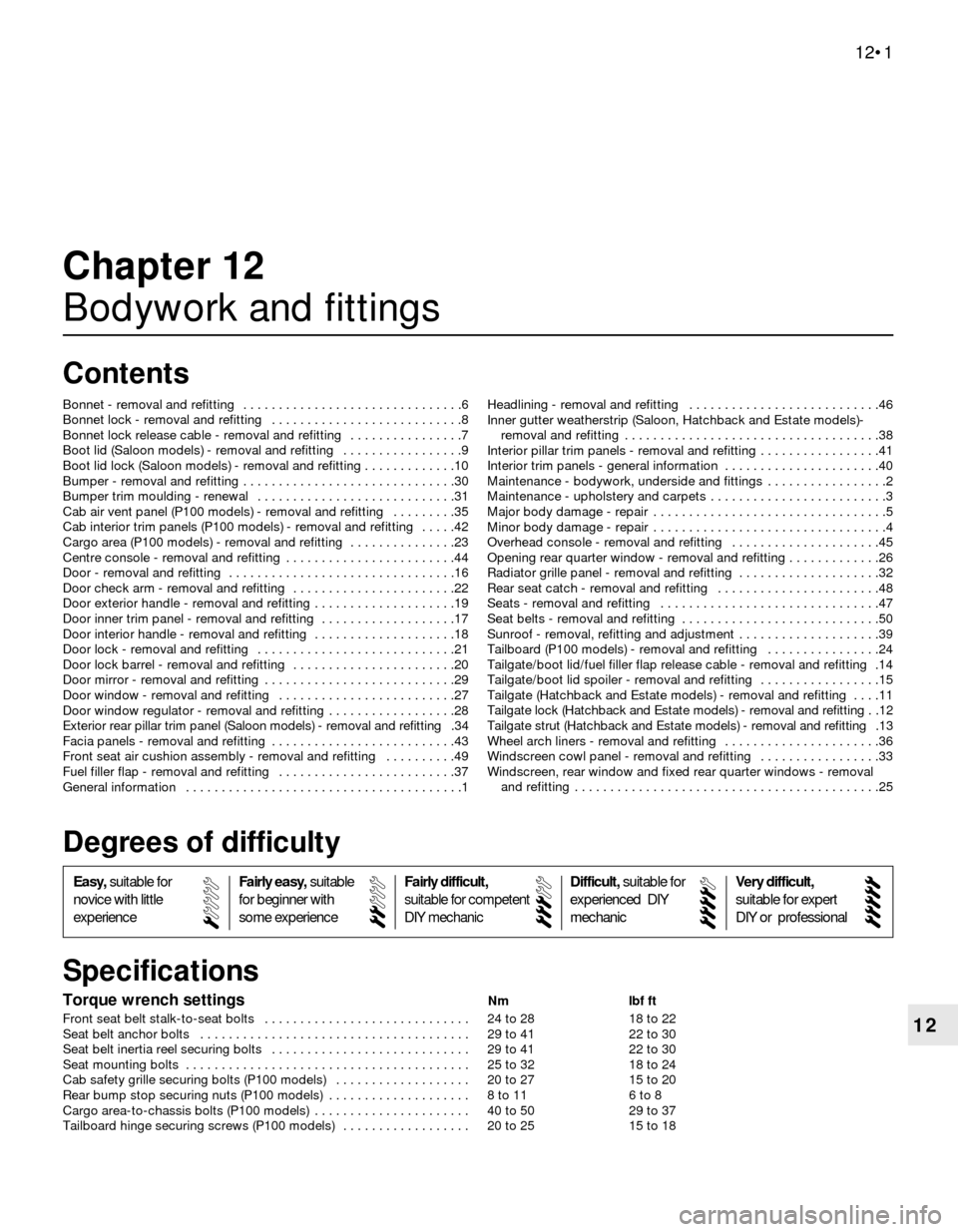
Torque wrench settingsNm lbf ft
Front seat belt stalk-to-seat bolts . . . . . . . . . . . . . . . . . . . . . . . . . . . . . 24 to 28 18 to 22
Seat belt anchor bolts . . . . . . . . . . . . . . . . . . . . . . . . . . . . . . . . . . . . . . 29 to 41 22 to 30
Seat belt inertia reel securing bolts . . . . . . . . . . . . . . . . . . . . . . . . . . . . 29 to 41 22 to 30
Seat mounting bolts . . . . . . . . . . . . . . . . . . . . . . . . . . . . . . . . . . . . . . . . 25 to 32 18 to 24
Cab safety grille securing bolts (P100 models) . . . . . . . . . . . . . . . . . . . 20 to 27 15 to 20
Rear bump stop securing nuts (P100 models) . . . . . . . . . . . . . . . . . . . . 8 to 11 6 to 8
Cargo area-to-chassis bolts (P100 models) . . . . . . . . . . . . . . . . . . . . . . 40 to 50 29 to 37
Tailboard hinge securing screws (P100 models) . . . . . . . . . . . . . . . . . . 20 to 25 15 to 18
Chapter 12
Bodywork and fittings
Bonnet - removal and refitting . . . . . . . . . . . . . . . . . . . . . . . . . . . . . . .6
Bonnet lock - removal and refitting . . . . . . . . . . . . . . . . . . . . . . . . . . .8
Bonnet lock release cable - removal and refitting . . . . . . . . . . . . . . . .7
Boot lid (Saloon models) - removal and refitting . . . . . . . . . . . . . . . . .9
Boot lid lock (Saloon models) - removal and refitting . . . . . . . . . . . . .10
Bumper - removal and refitting . . . . . . . . . . . . . . . . . . . . . . . . . . . . . .30
Bumper trim moulding - renewal . . . . . . . . . . . . . . . . . . . . . . . . . . . .31
Cab air vent panel (P100 models) - removal and refitting . . . . . . . . .35
Cab interior trim panels (P100 models) - removal and refitting . . . . .42
Cargo area (P100 models) - removal and refitting . . . . . . . . . . . . . . .23
Centre console - removal and refitting . . . . . . . . . . . . . . . . . . . . . . . .44
Door - removal and refitting . . . . . . . . . . . . . . . . . . . . . . . . . . . . . . . .16
Door check arm - removal and refitting . . . . . . . . . . . . . . . . . . . . . . .22
Door exterior handle - removal and refitting . . . . . . . . . . . . . . . . . . . .19
Door inner trim panel - removal and refitting . . . . . . . . . . . . . . . . . . .17
Door interior handle - removal and refitting . . . . . . . . . . . . . . . . . . . .18
Door lock - removal and refitting . . . . . . . . . . . . . . . . . . . . . . . . . . . .21
Door lock barrel - removal and refitting . . . . . . . . . . . . . . . . . . . . . . .20
Door mirror - removal and refitting . . . . . . . . . . . . . . . . . . . . . . . . . . .29
Door window - removal and refitting . . . . . . . . . . . . . . . . . . . . . . . . .27
Door window regulator - removal and refitting . . . . . . . . . . . . . . . . . .28
Exterior rear pillar trim panel (Saloon models) - removal and refitting .34
Facia panels - removal and refitting . . . . . . . . . . . . . . . . . . . . . . . . . .43
Front seat air cushion assembly - removal and refitting . . . . . . . . . .49
Fuel filler flap - removal and refitting . . . . . . . . . . . . . . . . . . . . . . . . .37
General information . . . . . . . . . . . . . . . . . . . . . . . . . . . . . . . . . . . . . . .1Headlining - removal and refitting . . . . . . . . . . . . . . . . . . . . . . . . . . .46
Inner gutter weatherstrip (Saloon, Hatchback and Estate models)-
removal and refitting . . . . . . . . . . . . . . . . . . . . . . . . . . . . . . . . . . . .38
Interior pillar trim panels - removal and refitting . . . . . . . . . . . . . . . . .41
Interior trim panels - general information . . . . . . . . . . . . . . . . . . . . . .40
Maintenance - bodywork, underside and fittings . . . . . . . . . . . . . . . . .2
Maintenance - upholstery and carpets . . . . . . . . . . . . . . . . . . . . . . . . .3
Major body damage - repair . . . . . . . . . . . . . . . . . . . . . . . . . . . . . . . . .5
Minor body damage - repair . . . . . . . . . . . . . . . . . . . . . . . . . . . . . . . . .4
Overhead console - removal and refitting . . . . . . . . . . . . . . . . . . . . .45
Opening rear quarter window - removal and refitting . . . . . . . . . . . . .26
Radiator grille panel - removal and refitting . . . . . . . . . . . . . . . . . . . .32
Rear seat catch - removal and refitting . . . . . . . . . . . . . . . . . . . . . . .48
Seats - removal and refitting . . . . . . . . . . . . . . . . . . . . . . . . . . . . . . .47
Seat belts - removal and refitting . . . . . . . . . . . . . . . . . . . . . . . . . . . .50
Sunroof - removal, refitting and adjustment . . . . . . . . . . . . . . . . . . . .39
Tailboard (P100 models) - removal and refitting . . . . . . . . . . . . . . . .24
Tailgate/boot lid/fuel filler flap release cable - removal and refitting .14
Tailgate/boot lid spoiler - removal and refitting . . . . . . . . . . . . . . . . .15
Tailgate (Hatchback and Estate models) - removal and refitting . . . .11
Tailgate lock (Hatchback and Estate models) - removal and refitting . .12
Tailgate strut (Hatchback and Estate models) - removal and refitting .13
Wheel arch liners - removal and refitting . . . . . . . . . . . . . . . . . . . . . .36
Windscreen cowl panel - removal and refitting . . . . . . . . . . . . . . . . .33
Windscreen, rear window and fixed rear quarter windows - removal
and refitting . . . . . . . . . . . . . . . . . . . . . . . . . . . . . . . . . . . . . . . . . . .25
12•1
Specifications Contents
12
Easy,suitable for
novice with little
experienceFairly easy,suitable
for beginner with
some experienceFairly difficult,
suitable for competent
DIY mechanic
Difficult,suitable for
experienced DIY
mechanicVery difficult,
suitable for expert
DIY or professional
Degrees of difficulty
Page 2 of 22
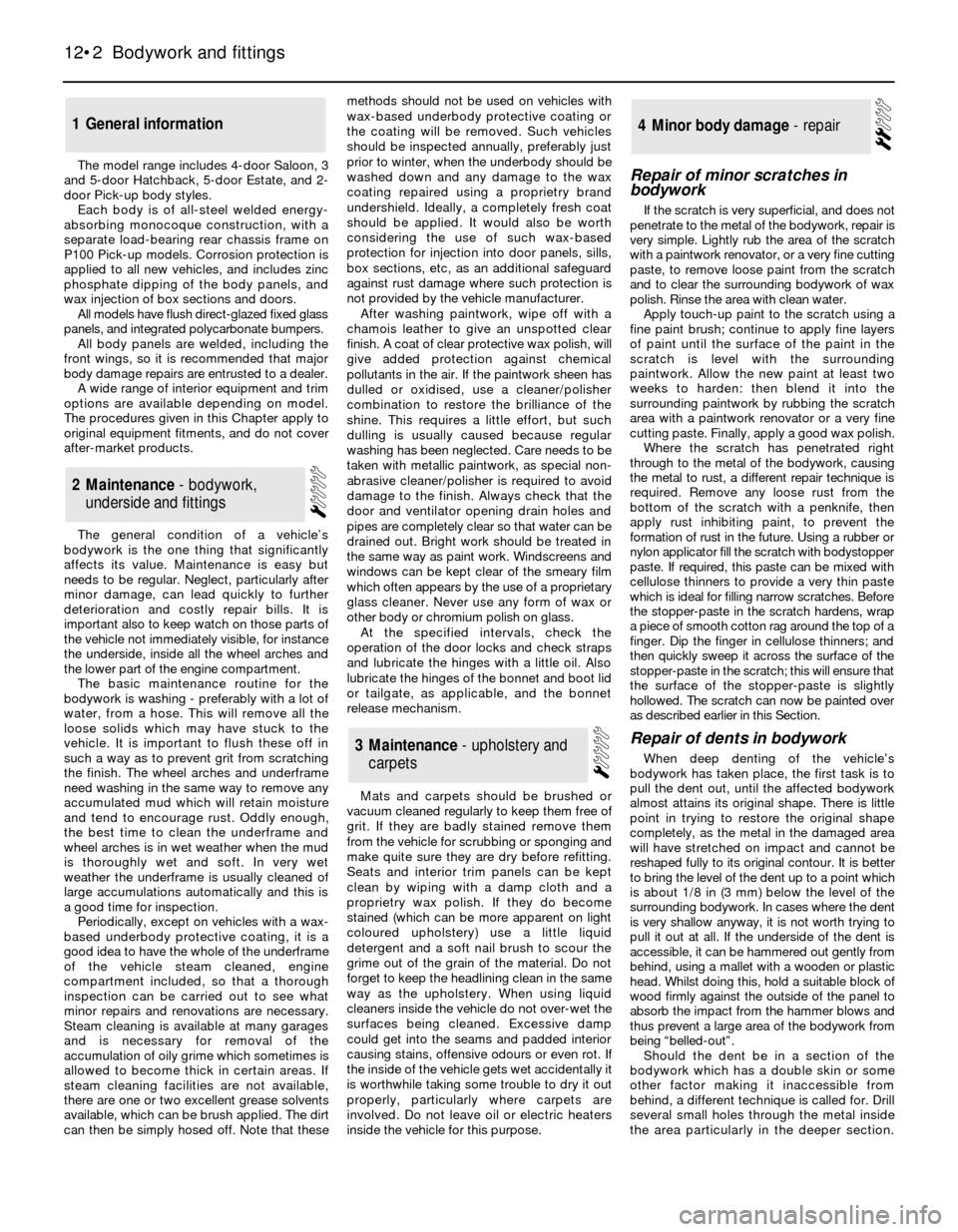
The model range includes 4-door Saloon, 3
and 5-door Hatchback, 5-door Estate, and 2-
door Pick-up body styles.
Each body is of all-steel welded energy-
absorbing monocoque construction, with a
separate load-bearing rear chassis frame on
P100 Pick-up models. Corrosion protection is
applied to all new vehicles, and includes zinc
phosphate dipping of the body panels, and
wax injection of box sections and doors.
All models have flush direct-glazed fixed glass
panels, and integrated polycarbonate bumpers.
All body panels are welded, including the
front wings, so it is recommended that major
body damage repairs are entrusted to a dealer.
A wide range of interior equipment and trim
options are available depending on model.
The procedures given in this Chapter apply to
original equipment fitments, and do not cover
after-market products.
The general condition of a vehicle’s
bodywork is the one thing that significantly
affects its value. Maintenance is easy but
needs to be regular. Neglect, particularly after
minor damage, can lead quickly to further
deterioration and costly repair bills. It is
important also to keep watch on those parts of
the vehicle not immediately visible, for instance
the underside, inside all the wheel arches and
the lower part of the engine compartment.
The basic maintenance routine for the
bodywork is washing - preferably with a lot of
water, from a hose. This will remove all the
loose solids which may have stuck to the
vehicle. It is important to flush these off in
such a way as to prevent grit from scratching
the finish. The wheel arches and underframe
need washing in the same way to remove any
accumulated mud which will retain moisture
and tend to encourage rust. Oddly enough,
the best time to clean the underframe and
wheel arches is in wet weather when the mud
is thoroughly wet and soft. In very wet
weather the underframe is usually cleaned of
large accumulations automatically and this is
a good time for inspection.
Periodically, except on vehicles with a wax-
based underbody protective coating, it is a
good idea to have the whole of the underframe
of the vehicle steam cleaned, engine
compartment included, so that a thorough
inspection can be carried out to see what
minor repairs and renovations are necessary.
Steam cleaning is available at many garages
and is necessary for removal of the
accumulation of oily grime which sometimes is
allowed to become thick in certain areas. If
steam cleaning facilities are not available,
there are one or two excellent grease solvents
available, which can be brush applied. The dirt
can then be simply hosed off. Note that thesemethods should not be used on vehicles with
wax-based underbody protective coating or
the coating will be removed. Such vehicles
should be inspected annually, preferably just
prior to winter, when the underbody should be
washed down and any damage to the wax
coating repaired using a proprietry brand
undershield. Ideally, a completely fresh coat
should be applied. It would also be worth
considering the use of such wax-based
protection for injection into door panels, sills,
box sections, etc, as an additional safeguard
against rust damage where such protection is
not provided by the vehicle manufacturer.
After washing paintwork, wipe off with a
chamois leather to give an unspotted clear
finish. A coat of clear protective wax polish, will
give added protection against chemical
pollutants in the air. If the paintwork sheen has
dulled or oxidised, use a cleaner/polisher
combination to restore the brilliance of the
shine. This requires a little effort, but such
dulling is usually caused because regular
washing has been neglected. Care needs to be
taken with metallic paintwork, as special non-
abrasive cleaner/polisher is required to avoid
damage to the finish. Always check that the
door and ventilator opening drain holes and
pipes are completely clear so that water can be
drained out. Bright work should be treated in
the same way as paint work. Windscreens and
windows can be kept clear of the smeary film
which often appears by the use of a proprietary
glass cleaner. Never use any form of wax or
other body or chromium polish on glass.
At the specified intervals, check the
operation of the door locks and check straps
and lubricate the hinges with a little oil. Also
lubricate the hinges of the bonnet and boot lid
or tailgate, as applicable, and the bonnet
release mechanism.
Mats and carpets should be brushed or
vacuum cleaned regularly to keep them free of
grit. If they are badly stained remove them
from the vehicle for scrubbing or sponging and
make quite sure they are dry before refitting.
Seats and interior trim panels can be kept
clean by wiping with a damp cloth and a
proprietry wax polish. If they do become
stained (which can be more apparent on light
coloured upholstery) use a little liquid
detergent and a soft nail brush to scour the
grime out of the grain of the material. Do not
forget to keep the headlining clean in the same
way as the upholstery. When using liquid
cleaners inside the vehicle do not over-wet the
surfaces being cleaned. Excessive damp
could get into the seams and padded interior
causing stains, offensive odours or even rot. If
the inside of the vehicle gets wet accidentally it
is worthwhile taking some trouble to dry it out
properly, particularly where carpets are
involved. Do not leave oil or electric heaters
inside the vehicle for this purpose.Repair of minor scratches in
bodywork
If the scratch is very superficial, and does not
penetrate to the metal of the bodywork, repair is
very simple. Lightly rub the area of the scratch
with a paintwork renovator, or a very fine cutting
paste, to remove loose paint from the scratch
and to clear the surrounding bodywork of wax
polish. Rinse the area with clean water.
Apply touch-up paint to the scratch using a
fine paint brush; continue to apply fine layers
of paint until the surface of the paint in the
scratch is level with the surrounding
paintwork. Allow the new paint at least two
weeks to harden: then blend it into the
surrounding paintwork by rubbing the scratch
area with a paintwork renovator or a very fine
cutting paste. Finally, apply a good wax polish.
Where the scratch has penetrated right
through to the metal of the bodywork, causing
the metal to rust, a different repair technique is
required. Remove any loose rust from the
bottom of the scratch with a penknife, then
apply rust inhibiting paint, to prevent the
formation of rust in the future. Using a rubber or
nylon applicator fill the scratch with bodystopper
paste. If required, this paste can be mixed with
cellulose thinners to provide a very thin paste
which is ideal for filling narrow scratches. Before
the stopper-paste in the scratch hardens, wrap
a piece of smooth cotton rag around the top of a
finger. Dip the finger in cellulose thinners; and
then quickly sweep it across the surface of the
stopper-paste in the scratch; this will ensure that
the surface of the stopper-paste is slightly
hollowed. The scratch can now be painted over
as described earlier in this Section.
Repair of dents in bodywork
When deep denting of the vehicle’s
bodywork has taken place, the first task is to
pull the dent out, until the affected bodywork
almost attains its original shape. There is little
point in trying to restore the original shape
completely, as the metal in the damaged area
will have stretched on impact and cannot be
reshaped fully to its original contour. It is better
to bring the level of the dent up to a point which
is about 1/8 in (3 mm) below the level of the
surrounding bodywork. In cases where the dent
is very shallow anyway, it is not worth trying to
pull it out at all. If the underside of the dent is
accessible, it can be hammered out gently from
behind, using a mallet with a wooden or plastic
head. Whilst doing this, hold a suitable block of
wood firmly against the outside of the panel to
absorb the impact from the hammer blows and
thus prevent a large area of the bodywork from
being “belled-out”.
Should the dent be in a section of the
bodywork which has a double skin or some
other factor making it inaccessible from
behind, a different technique is called for. Drill
several small holes through the metal inside
the area particularly in the deeper section.
4Minor body damage - repair
3Maintenance - upholstery and
carpets
2Maintenance - bodywork,
underside and fittings
1General information
12•2Bodywork and fittings
Page 6 of 22
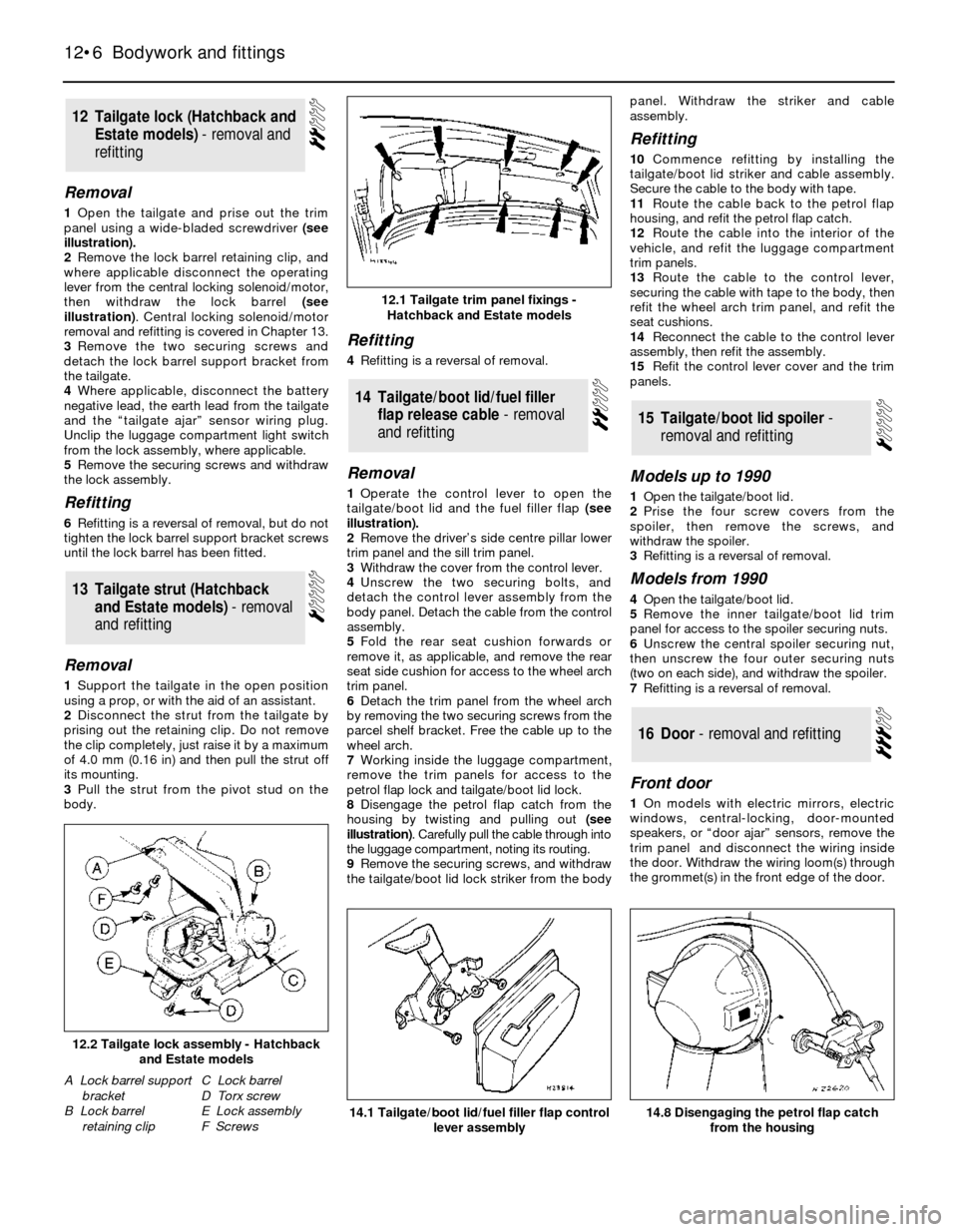
Removal
1Open the tailgate and prise out the trim
panel using a wide-bladed screwdriver(see
illustration).
2Remove the lock barrel retaining clip, and
where applicable disconnect the operating
lever from the central locking solenoid/motor,
then withdraw the lock barrel (see
illustration). Central locking solenoid/motor
removal and refitting is covered in Chapter 13.
3Remove the two securing screws and
detach the lock barrel support bracket from
the tailgate.
4Where applicable, disconnect the battery
negative lead, the earth lead from the tailgate
and the “tailgate ajar” sensor wiring plug.
Unclip the luggage compartment light switch
from the lock assembly, where applicable.
5Remove the securing screws and withdraw
the lock assembly.
Refitting
6Refitting is a reversal of removal, but do not
tighten the lock barrel support bracket screws
until the lock barrel has been fitted.
Removal
1Support the tailgate in the open position
using a prop, or with the aid of an assistant.
2Disconnect the strut from the tailgate by
prising out the retaining clip. Do not remove
the clip completely, just raise it by a maximum
of 4.0 mm (0.16 in) and then pull the strut off
its mounting.
3Pull the strut from the pivot stud on the
body.
Refitting
4Refitting is a reversal of removal.
Removal
1Operate the control lever to open the
tailgate/boot lid and the fuel filler flap (see
illustration).
2Remove the driver’s side centre pillar lower
trim panel and the sill trim panel.
3Withdraw the cover from the control lever.
4Unscrew the two securing bolts, and
detach the control lever assembly from the
body panel. Detach the cable from the control
assembly.
5Fold the rear seat cushion forwards or
remove it, as applicable, and remove the rear
seat side cushion for access to the wheel arch
trim panel.
6Detach the trim panel from the wheel arch
by removing the two securing screws from the
parcel shelf bracket. Free the cable up to the
wheel arch.
7Working inside the luggage compartment,
remove the trim panels for access to the
petrol flap lock and tailgate/boot lid lock.
8Disengage the petrol flap catch from the
housing by twisting and pulling out (see
illustration). Carefully pull the cable through into
the luggage compartment, noting its routing.
9Remove the securing screws, and withdraw
the tailgate/boot lid lock striker from the bodypanel. Withdraw the striker and cable
assembly.
Refitting
10Commence refitting by installing the
tailgate/boot lid striker and cable assembly.
Secure the cable to the body with tape.
11Route the cable back to the petrol flap
housing, and refit the petrol flap catch.
12Route the cable into the interior of the
vehicle, and refit the luggage compartment
trim panels.
13Route the cable to the control lever,
securing the cable with tape to the body, then
refit the wheel arch trim panel, and refit the
seat cushions.
14Reconnect the cable to the control lever
assembly, then refit the assembly.
15Refit the control lever cover and the trim
panels.
Models up to 1990
1Open the tailgate/boot lid.
2Prise the four screw covers from the
spoiler, then remove the screws, and
withdraw the spoiler.
3Refitting is a reversal of removal.
Models from 1990
4Open the tailgate/boot lid.
5Remove the inner tailgate/boot lid trim
panel for access to the spoiler securing nuts.
6Unscrew the central spoiler securing nut,
then unscrew the four outer securing nuts
(two on each side), and withdraw the spoiler.
7Refitting is a reversal of removal.
Front door
1On models with electric mirrors, electric
windows, central-locking, door-mounted
speakers, or “door ajar” sensors, remove the
trim panel and disconnect the wiring inside
the door. Withdraw the wiring loom(s) through
the grommet(s) in the front edge of the door.
16Door - removal and refitting
15Tailgate/boot lid spoiler -
removal and refitting
14Tailgate/boot lid/fuel filler
flap release cable - removal
and refitting
13Tailgate strut (Hatchback
and Estate models) - removal
and refitting
12Tailgate lock (Hatchback and
Estate models) - removal and
refitting
12•6Bodywork and fittings
14.1 Tailgate/boot lid/fuel filler flap control
lever assembly14.8 Disengaging the petrol flap catch
from the housing
12.2 Tailgate lock assembly - Hatchback
and Estate models
A Lock barrel support
bracket
B Lock barrel
retaining clipC Lock barrel
D Torx screw
E Lock assembly
F Screws
12.1 Tailgate trim panel fixings -
Hatchback and Estate models
Page 13 of 22
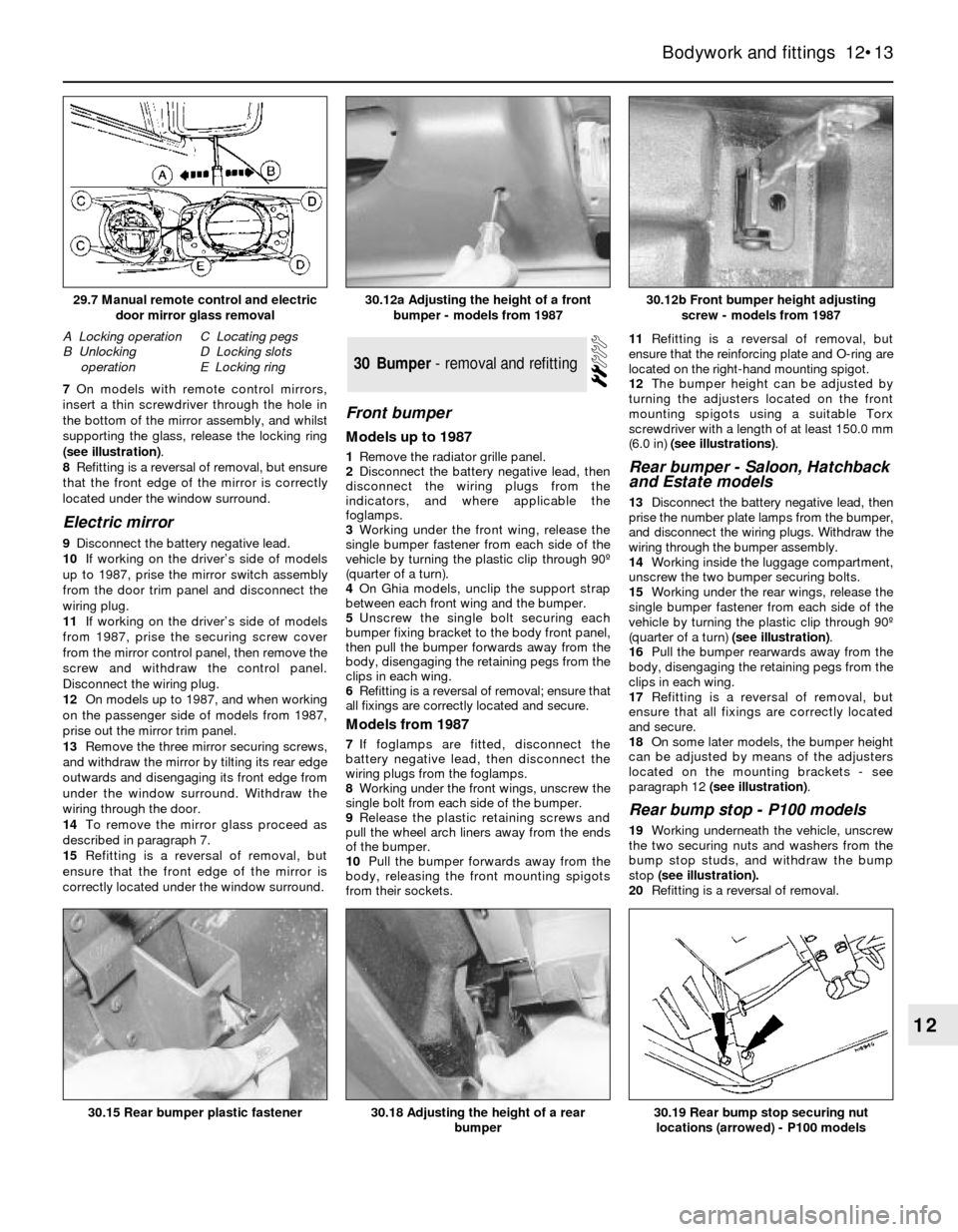
7On models with remote control mirrors,
insert a thin screwdriver through the hole in
the bottom of the mirror assembly, and whilst
supporting the glass, release the locking ring
(see illustration).
8Refitting is a reversal of removal, but ensure
that the front edge of the mirror is correctly
located under the window surround.
Electric mirror
9Disconnect the battery negative lead.
10If working on the driver’s side of models
up to 1987, prise the mirror switch assembly
from the door trim panel and disconnect the
wiring plug.
11If working on the driver’s side of models
from 1987, prise the securing screw cover
from the mirror control panel, then remove the
screw and withdraw the control panel.
Disconnect the wiring plug.
12On models up to 1987, and when working
on the passenger side of models from 1987,
prise out the mirror trim panel.
13Remove the three mirror securing screws,
and withdraw the mirror by tilting its rear edge
outwards and disengaging its front edge from
under the window surround. Withdraw the
wiring through the door.
14To remove the mirror glass proceed as
described in paragraph 7.
15Refitting is a reversal of removal, but
ensure that the front edge of the mirror is
correctly located under the window surround.
Front bumper
Models up to 1987
1Remove the radiator grille panel.
2Disconnect the battery negative lead, then
disconnect the wiring plugs from the
indicators, and where applicable the
foglamps.
3Working under the front wing, release the
single bumper fastener from each side of the
vehicle by turning the plastic clip through 90º
(quarter of a turn).
4On Ghia models, unclip the support strap
between each front wing and the bumper.
5Unscrew the single bolt securing each
bumper fixing bracket to the body front panel,
then pull the bumper forwards away from the
body, disengaging the retaining pegs from the
clips in each wing.
6Refitting is a reversal of removal; ensure that
all fixings are correctly located and secure.
Models from 1987
7If foglamps are fitted, disconnect the
battery negative lead, then disconnect the
wiring plugs from the foglamps.
8Working under the front wings, unscrew the
single bolt from each side of the bumper.
9Release the plastic retaining screws and
pull the wheel arch liners away from the ends
of the bumper.
10Pull the bumper forwards away from the
body, releasing the front mounting spigots
from their sockets.11Refitting is a reversal of removal, but
ensure that the reinforcing plate and O-ring are
located on the right-hand mounting spigot.
12The bumper height can be adjusted by
turning the adjusters located on the front
mounting spigots using a suitable Torx
screwdriver with a length of at least 150.0 mm
(6.0 in) (see illustrations).
Rear bumper - Saloon, Hatchback
and Estate models
13Disconnect the battery negative lead, then
prise the number plate lamps from the bumper,
and disconnect the wiring plugs. Withdraw the
wiring through the bumper assembly.
14Working inside the luggage compartment,
unscrew the two bumper securing bolts.
15Working under the rear wings, release the
single bumper fastener from each side of the
vehicle by turning the plastic clip through 90º
(quarter of a turn) (see illustration).
16Pull the bumper rearwards away from the
body, disengaging the retaining pegs from the
clips in each wing.
17Refitting is a reversal of removal, but
ensure that all fixings are correctly located
and secure.
18On some later models, the bumper height
can be adjusted by means of the adjusters
located on the mounting brackets - see
paragraph 12 (see illustration).
Rear bump stop - P100 models
19Working underneath the vehicle, unscrew
the two securing nuts and washers from the
bump stop studs, and withdraw the bump
stop (see illustration).
20Refitting is a reversal of removal.
30Bumper - removal and refitting
Bodywork and fittings 12•13
12
30.15 Rear bumper plastic fastener30.19 Rear bump stop securing nut
locations (arrowed) - P100 models30.18 Adjusting the height of a rear
bumper
30.12b Front bumper height adjusting
screw - models from 198730.12a Adjusting the height of a front
bumper - models from 198729.7 Manual remote control and electric
door mirror glass removal
A Locking operation
B Unlocking
operationC Locating pegs
D Locking slots
E Locking ring
Page 14 of 22
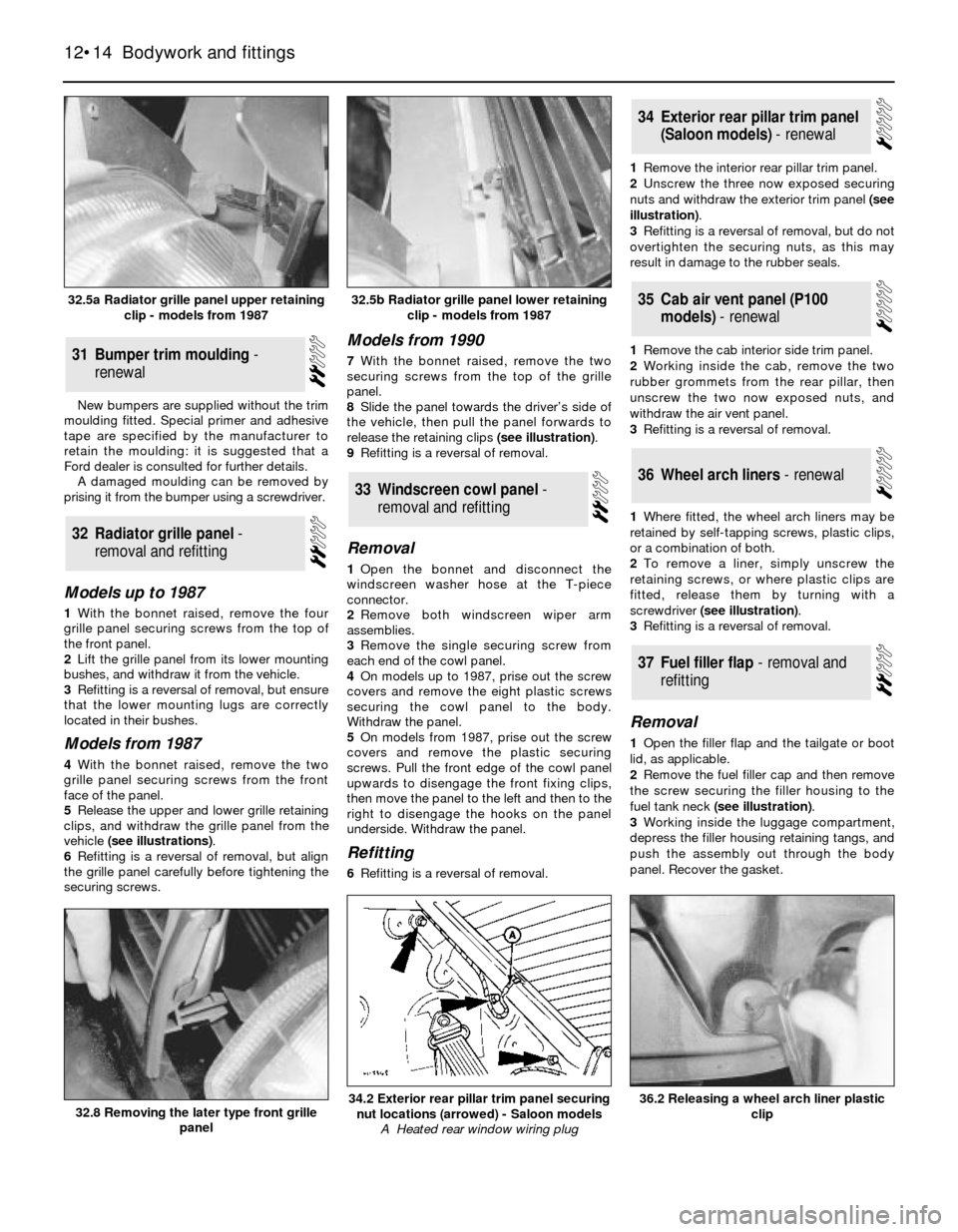
New bumpers are supplied without the trim
moulding fitted. Special primer and adhesive
tape are specified by the manufacturer to
retain the moulding: it is suggested that a
Ford dealer is consulted for further details.
A damaged moulding can be removed by
prising it from the bumper using a screwdriver.
Models up to 1987
1With the bonnet raised, remove the four
grille panel securing screws from the top of
the front panel.
2Lift the grille panel from its lower mounting
bushes, and withdraw it from the vehicle.
3Refitting is a reversal of removal, but ensure
that the lower mounting lugs are correctly
located in their bushes.
Models from 1987
4With the bonnet raised, remove the two
grille panel securing screws from the front
face of the panel.
5Release the upper and lower grille retaining
clips, and withdraw the grille panel from the
vehicle (see illustrations).
6Refitting is a reversal of removal, but align
the grille panel carefully before tightening the
securing screws.
Models from 1990
7With the bonnet raised, remove the two
securing screws from the top of the grille
panel.
8Slide the panel towards the driver’s side of
the vehicle, then pull the panel forwards to
release the retaining clips (see illustration).
9Refitting is a reversal of removal.
Removal
1Open the bonnet and disconnect the
windscreen washer hose at the T-piece
connector.
2Remove both windscreen wiper arm
assemblies.
3Remove the single securing screw from
each end of the cowl panel.
4On models up to 1987, prise out the screw
covers and remove the eight plastic screws
securing the cowl panel to the body.
Withdraw the panel.
5On models from 1987, prise out the screw
covers and remove the plastic securing
screws. Pull the front edge of the cowl panel
upwards to disengage the front fixing clips,
then move the panel to the left and then to the
right to disengage the hooks on the panel
underside. Withdraw the panel.
Refitting
6Refitting is a reversal of removal.1Remove the interior rear pillar trim panel.
2Unscrew the three now exposed securing
nuts and withdraw the exterior trim panel (see
illustration).
3Refitting is a reversal of removal, but do not
overtighten the securing nuts, as this may
result in damage to the rubber seals.
1Remove the cab interior side trim panel.
2Working inside the cab, remove the two
rubber grommets from the rear pillar, then
unscrew the two now exposed nuts, and
withdraw the air vent panel.
3Refitting is a reversal of removal.
1Where fitted, the wheel arch liners may be
retained by self-tapping screws, plastic clips,
or a combination of both.
2To remove a liner, simply unscrew the
retaining screws, or where plastic clips are
fitted, release them by turning with a
screwdriver (see illustration).
3Refitting is a reversal of removal.
Removal
1Open the filler flap and the tailgate or boot
lid, as applicable.
2Remove the fuel filler cap and then remove
the screw securing the filler housing to the
fuel tank neck (see illustration).
3Working inside the luggage compartment,
depress the filler housing retaining tangs, and
push the assembly out through the body
panel. Recover the gasket.
37Fuel filler flap - removal and
refitting
36Wheel arch liners - renewal
35Cab air vent panel (P100
models) - renewal
34Exterior rear pillar trim panel
(Saloon models) - renewal
33Windscreen cowl panel -
removal and refitting
32Radiator grille panel -
removal and refitting
31Bumper trim moulding -
renewal
12•14Bodywork and fittings
32.8 Removing the later type front grille
panel36.2 Releasing a wheel arch liner plastic
clip34.2 Exterior rear pillar trim panel securing
nut locations (arrowed) - Saloon models
A Heated rear window wiring plug
32.5b Radiator grille panel lower retaining
clip - models from 198732.5a Radiator grille panel upper retaining
clip - models from 1987
Page 16 of 22
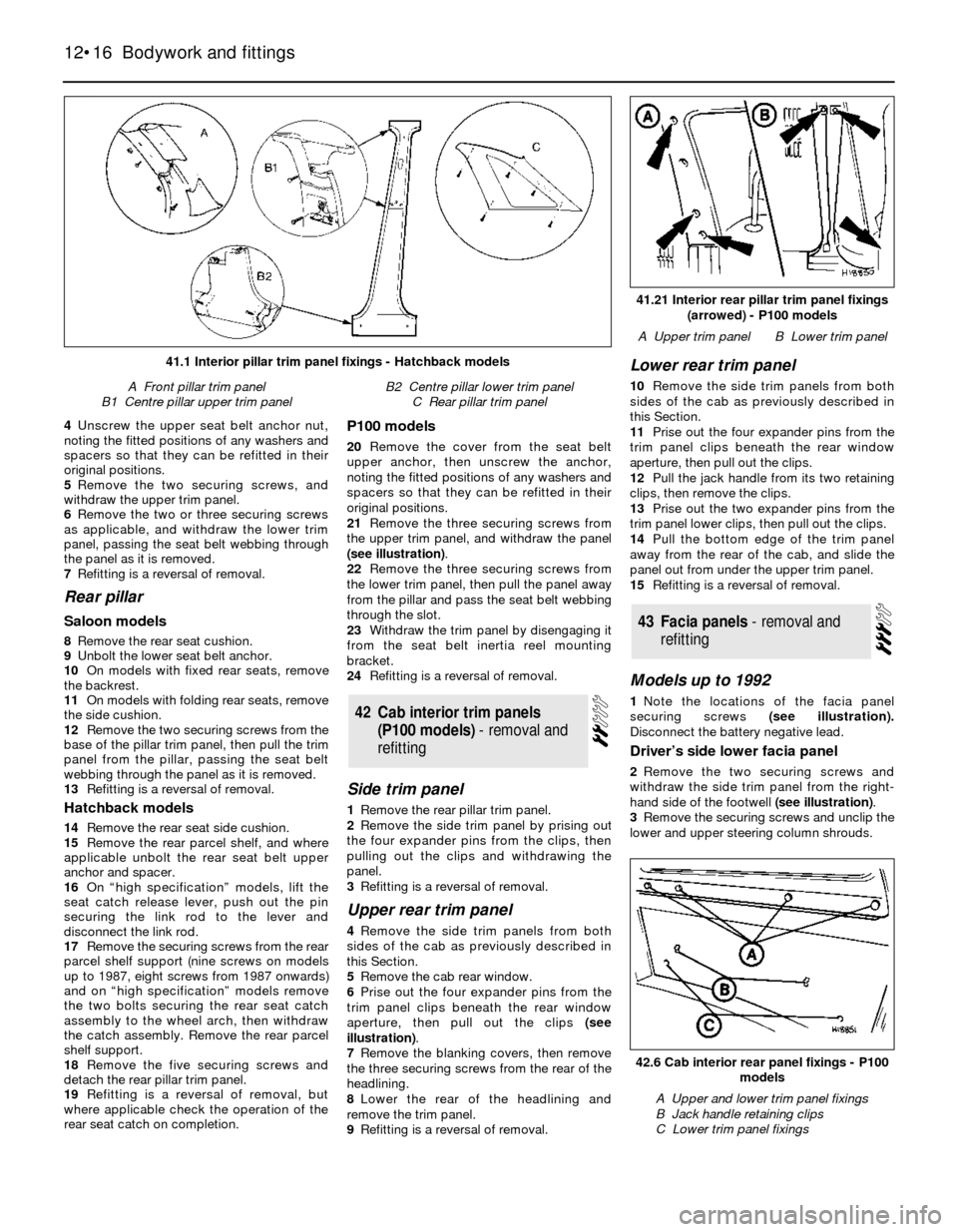
4Unscrew the upper seat belt anchor nut,
noting the fitted positions of any washers and
spacers so that they can be refitted in their
original positions.
5Remove the two securing screws, and
withdraw the upper trim panel.
6Remove the two or three securing screws
as applicable, and withdraw the lower trim
panel, passing the seat belt webbing through
the panel as it is removed.
7Refitting is a reversal of removal.
Rear pillar
Saloon models
8Remove the rear seat cushion.
9Unbolt the lower seat belt anchor.
10On models with fixed rear seats, remove
the backrest.
11On models with folding rear seats, remove
the side cushion.
12Remove the two securing screws from the
base of the pillar trim panel, then pull the trim
panel from the pillar, passing the seat belt
webbing through the panel as it is removed.
13Refitting is a reversal of removal.
Hatchback models
14Remove the rear seat side cushion.
15Remove the rear parcel shelf, and where
applicable unbolt the rear seat belt upper
anchor and spacer.
16On “high specification” models, lift the
seat catch release lever, push out the pin
securing the link rod to the lever and
disconnect the link rod.
17Remove the securing screws from the rear
parcel shelf support (nine screws on models
up to 1987, eight screws from 1987 onwards)
and on “high specification” models remove
the two bolts securing the rear seat catch
assembly to the wheel arch, then withdraw
the catch assembly. Remove the rear parcel
shelf support.
18Remove the five securing screws and
detach the rear pillar trim panel.
19Refitting is a reversal of removal, but
where applicable check the operation of the
rear seat catch on completion.
P100 models
20Remove the cover from the seat belt
upper anchor, then unscrew the anchor,
noting the fitted positions of any washers and
spacers so that they can be refitted in their
original positions.
21Remove the three securing screws from
the upper trim panel, and withdraw the panel
(see illustration).
22Remove the three securing screws from
the lower trim panel, then pull the panel away
from the pillar and pass the seat belt webbing
through the slot.
23Withdraw the trim panel by disengaging it
from the seat belt inertia reel mounting
bracket.
24Refitting is a reversal of removal.
Side trim panel
1Remove the rear pillar trim panel.
2Remove the side trim panel by prising out
the four expander pins from the clips, then
pulling out the clips and withdrawing the
panel.
3Refitting is a reversal of removal.
Upper rear trim panel
4Remove the side trim panels from both
sides of the cab as previously described in
this Section.
5Remove the cab rear window.
6Prise out the four expander pins from the
trim panel clips beneath the rear window
aperture, then pull out the clips (see
illustration).
7Remove the blanking covers, then remove
the three securing screws from the rear of the
headlining.
8Lower the rear of the headlining and
remove the trim panel.
9Refitting is a reversal of removal.
Lower rear trim panel
10Remove the side trim panels from both
sides of the cab as previously described in
this Section.
11Prise out the four expander pins from the
trim panel clips beneath the rear window
aperture, then pull out the clips.
12Pull the jack handle from its two retaining
clips, then remove the clips.
13Prise out the two expander pins from the
trim panel lower clips, then pull out the clips.
14Pull the bottom edge of the trim panel
away from the rear of the cab, and slide the
panel out from under the upper trim panel.
15Refitting is a reversal of removal.
Models up to 1992
1Note the locations of the facia panel
securing screws (see illustration).
Disconnect the battery negative lead.
Driver’s side lower facia panel
2Remove the two securing screws and
withdraw the side trim panel from the right-
hand side of the footwell (see illustration).
3Remove the securing screws and unclip the
lower and upper steering column shrouds.
43Facia panels - removal and
refitting
42Cab interior trim panels
(P100 models) - removal and
refitting
12•16Bodywork and fittings
42.6 Cab interior rear panel fixings - P100
models
A Upper and lower trim panel fixings
B Jack handle retaining clips
C Lower trim panel fixings
41.21 Interior rear pillar trim panel fixings
(arrowed) - P100 models
A Upper trim panelB Lower trim panel
41.1 Interior pillar trim panel fixings - Hatchback models
A Front pillar trim panel
B1 Centre pillar upper trim panelB2 Centre pillar lower trim panel
C Rear pillar trim panel
Page 18 of 22
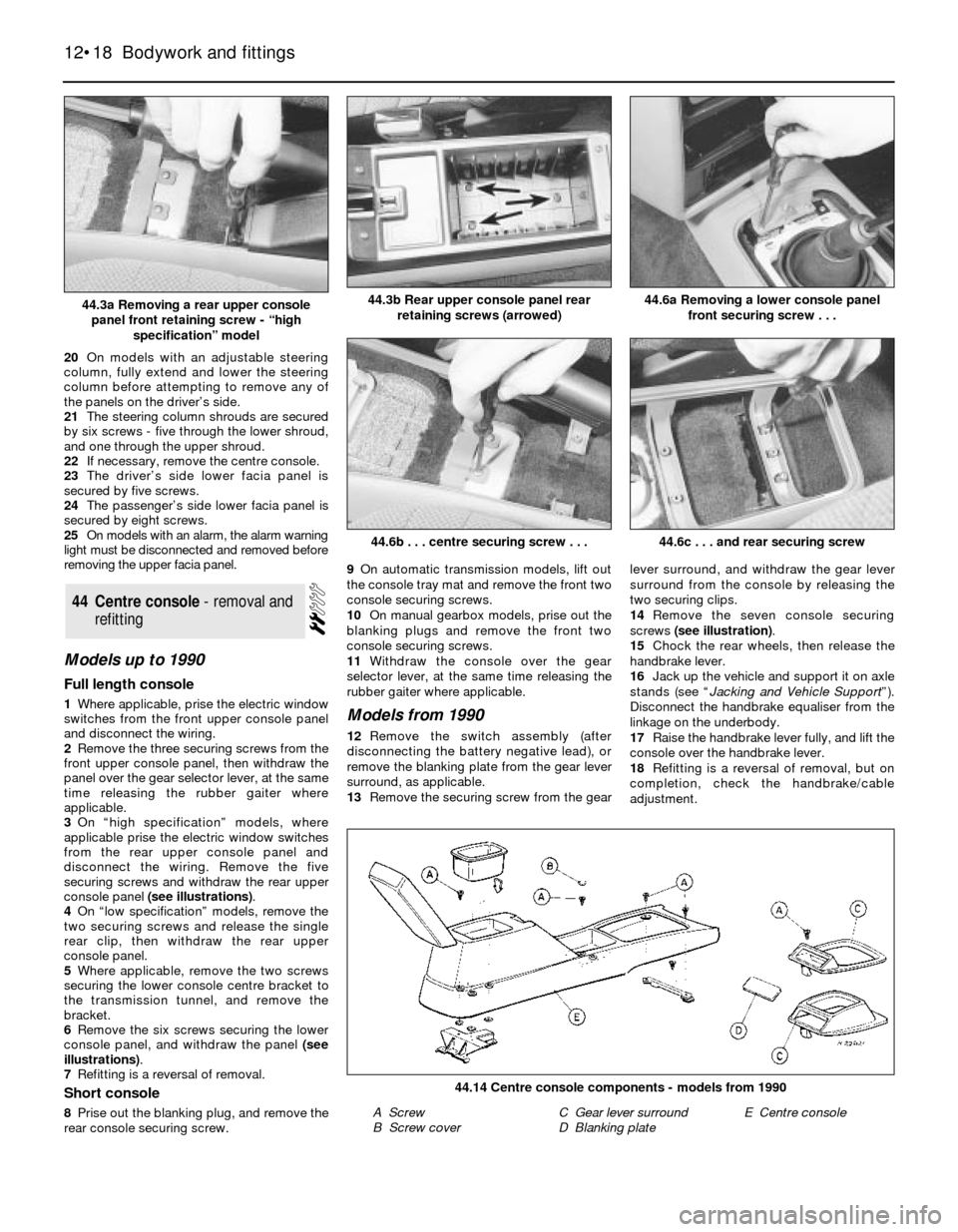
20On models with an adjustable steering
column, fully extend and lower the steering
column before attempting to remove any of
the panels on the driver’s side.
21The steering column shrouds are secured
by six screws - five through the lower shroud,
and one through the upper shroud.
22If necessary, remove the centre console.
23The driver’s side lower facia panel is
secured by five screws.
24The passenger’s side lower facia panel is
secured by eight screws.
25On models with an alarm, the alarm warning
light must be disconnected and removed before
removing the upper facia panel.
Models up to 1990
Full length console
1Where applicable, prise the electric window
switches from the front upper console panel
and disconnect the wiring.
2Remove the three securing screws from the
front upper console panel, then withdraw the
panel over the gear selector lever, at the same
time releasing the rubber gaiter where
applicable.
3On “high specification” models, where
applicable prise the electric window switches
from the rear upper console panel and
disconnect the wiring. Remove the five
securing screws and withdraw the rear upper
console panel (see illustrations).
4On “low specification” models, remove the
two securing screws and release the single
rear clip, then withdraw the rear upper
console panel.
5Where applicable, remove the two screws
securing the lower console centre bracket to
the transmission tunnel, and remove the
bracket.
6Remove the six screws securing the lower
console panel, and withdraw the panel (see
illustrations).
7Refitting is a reversal of removal.
Short console
8Prise out the blanking plug, and remove the
rear console securing screw.9On automatic transmission models, lift out
the console tray mat and remove the front two
console securing screws.
10On manual gearbox models, prise out the
blanking plugs and remove the front two
console securing screws.
11Withdraw the console over the gear
selector lever, at the same time releasing the
rubber gaiter where applicable.
Models from 1990
12Remove the switch assembly (after
disconnecting the battery negative lead), or
remove the blanking plate from the gear lever
surround, as applicable.
13Remove the securing screw from the gearlever surround, and withdraw the gear lever
surround from the console by releasing the
two securing clips.
14Remove the seven console securing
screws (see illustration).
15Chock the rear wheels, then release the
handbrake lever.
16Jack up the vehicle and support it on axle
stands (see “Jacking and Vehicle Support”).
Disconnect the handbrake equaliser from the
linkage on the underbody.
17Raise the handbrake lever fully, and lift the
console over the handbrake lever.
18Refitting is a reversal of removal, but on
completion, check the handbrake/cable
adjustment.
44Centre console - removal and
refitting
12•18Bodywork and fittings
44.3b Rear upper console panel rear
retaining screws (arrowed)
44.6b . . . centre securing screw . . .
44.14 Centre console components - models from 1990
A Screw
B Screw coverC Gear lever surround
D Blanking plateE Centre console
44.6c . . . and rear securing screw
44.6a Removing a lower console panel
front securing screw . . .44.3a Removing a rear upper console
panel front retaining screw - “high
specification” model
Page 20 of 22
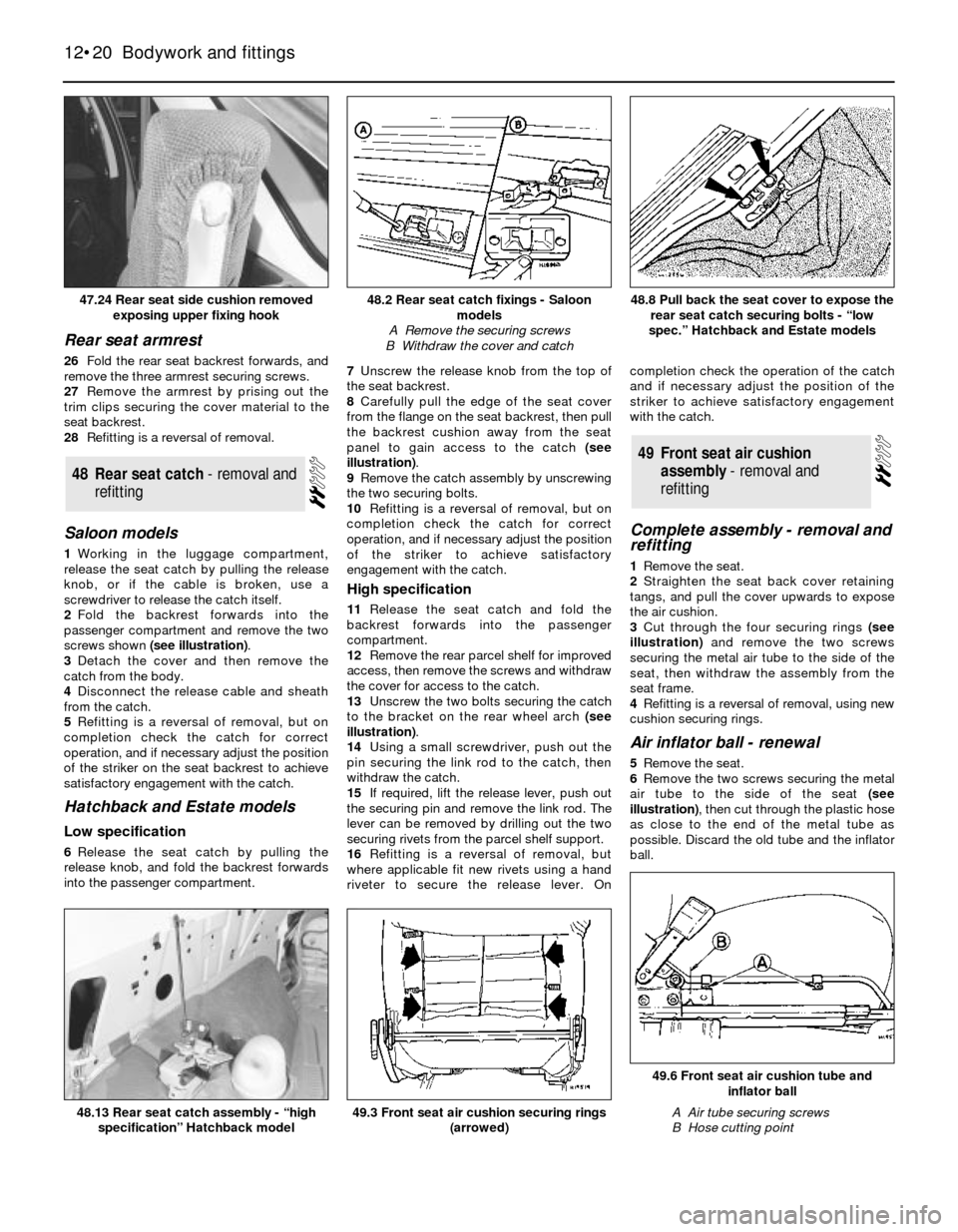
Rear seat armrest
26Fold the rear seat backrest forwards, and
remove the three armrest securing screws.
27Remove the armrest by prising out the
trim clips securing the cover material to the
seat backrest.
28Refitting is a reversal of removal.
Saloon models
1Working in the luggage compartment,
release the seat catch by pulling the release
knob, or if the cable is broken, use a
screwdriver to release the catch itself.
2Fold the backrest forwards into the
passenger compartment and remove the two
screws shown (see illustration).
3Detach the cover and then remove the
catch from the body.
4Disconnect the release cable and sheath
from the catch.
5Refitting is a reversal of removal, but on
completion check the catch for correct
operation, and if necessary adjust the position
of the striker on the seat backrest to achieve
satisfactory engagement with the catch.
Hatchback and Estate models
Low specification
6Release the seat catch by pulling the
release knob, and fold the backrest forwards
into the passenger compartment.7Unscrew the release knob from the top of
the seat backrest.
8Carefully pull the edge of the seat cover
from the flange on the seat backrest, then pull
the backrest cushion away from the seat
panel to gain access to the catch (see
illustration).
9Remove the catch assembly by unscrewing
the two securing bolts.
10Refitting is a reversal of removal, but on
completion check the catch for correct
operation, and if necessary adjust the position
of the striker to achieve satisfactory
engagement with the catch.
High specification
11Release the seat catch and fold the
backrest forwards into the passenger
compartment.
12Remove the rear parcel shelf for improved
access, then remove the screws and withdraw
the cover for access to the catch.
13Unscrew the two bolts securing the catch
to the bracket on the rear wheel arch (see
illustration).
14Using a small screwdriver, push out the
pin securing the link rod to the catch, then
withdraw the catch.
15If required, lift the release lever, push out
the securing pin and remove the link rod. The
lever can be removed by drilling out the two
securing rivets from the parcel shelf support.
16Refitting is a reversal of removal, but
where applicable fit new rivets using a hand
riveter to secure the release lever. Oncompletion check the operation of the catch
and if necessary adjust the position of the
striker to achieve satisfactory engagement
with the catch.
Complete assembly - removal and
refitting
1Remove the seat.
2Straighten the seat back cover retaining
tangs, and pull the cover upwards to expose
the air cushion.
3Cut through the four securing rings (see
illustration)and remove the two screws
securing the metal air tube to the side of the
seat, then withdraw the assembly from the
seat frame.
4Refitting is a reversal of removal, using new
cushion securing rings.
Air inflator ball - renewal
5Remove the seat.
6Remove the two screws securing the metal
air tube to the side of the seat (see
illustration), then cut through the plastic hose
as close to the end of the metal tube as
possible. Discard the old tube and the inflator
ball.
49Front seat air cushion
assembly - removal and
refitting
48Rear seat catch - removal and
refitting
12•20Bodywork and fittings
48.8 Pull back the seat cover to expose the
rear seat catch securing bolts - “low
spec.” Hatchback and Estate models
49.3 Front seat air cushion securing rings
(arrowed)
49.6 Front seat air cushion tube and
inflator ball
A Air tube securing screws
B Hose cutting point48.13 Rear seat catch assembly - “high
specification” Hatchback model
48.2 Rear seat catch fixings - Saloon
models
A Remove the securing screws
B Withdraw the cover and catch47.24 Rear seat side cushion removed
exposing upper fixing hook